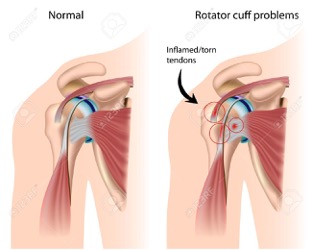
What is shoulder impingement syndrome (SIS) and how can I help my client?
As Pilates practitioners we commonly see clients with painful shoulders. Shoulder impingement syndrome (SIS) is one such very commonly seen condition. SIS is a term that may cover many conditions including: shoulder bursitis, rotator cuff tendonitis, supraspinatus tendonitis, subacromial impingement, painful arc syndrome, swimmer’s shoulder, rotator cuff syndrome and thrower’s shoulder. We should encourage our clients presenting with a painful shoulder (especially if the pain has been there for more than a week) to seek an opinion from their GP or allied health practitioner.
SIS is a condition where there is pain, possible weakness and/or decrease in range of movement in the shoulder. This pain is usually associated with overhead movements and can be felt at night – especially if the person sleeps on the affected side. SIS is commonly seen in people with repetitive physically active jobs or hobbies that use their arm at or above shoulder height, such as swimmers, throwers, construction workers, bus drivers, hairdressers, florists and jugglers and so on. SIS is also seen in ageing clients when rotator cuff muscles and tendons have degenerated. It is also commonly associated with an increase in thoracic kyphosis.
There are two important anatomical concepts to understand with SIS. Firstly, the subacromial space is the area formed between the acromial arch and the head of the humerus. Secondly, the structures within this subacromial space are the belly and tendon of the supraspinatus muscle, long head of the bicep tendon, a portion of the glenohumeral joint capsule and the subacromial bursa. Impingement occurs when the arm is raised and the subacromial space is either too small for its contents, or the contents are too large for the space, or a combination of both. This compression causes pain and inflammation, thus restricting pain free movement.
Our job as Pilates practitioners is to improve the quality of shoulder movement in a pain free range. Our clients may complain of a painful catching, or painful zone and some say that they want to push through and ‘stretch it out’. We must explain to them that we should not be pushing through or working into pain because it can make the problem worse and prevent recovery. We should aim to improve the movement quality and decrease the compensatory movement patterns of our clients. If you suspect pathology, or if the client does not improve, then you should refer the client to be assessed by a clinician. SIS can take 3-6 months (or longer) to resolve and regular communication with the client’s physiotherapist or treating clinician is recommended.
The exercises for clients with SIS aim to:
- Improve cervical and thoracic posture
- Improve movement quality of the shoulder and arm
- Increase thoracic extension
- Strengthen the mid and upper back muscles
- Stretch the pectoral muscles and upper trapezius
- Strengthen the lattissimus dorsi, rhomboids, lower trapezius, serratus anterior
- Teach awareness of the scapula on the rib cage
- Decrease tension in the upper trapezius and levator scapula muscles
Common exercises for clients with SIS include:
- Prone extension/dart for thoracic extension
- Quadruped for scapula awareness and stability
- Chest expansion and chariots for upper back strength
- Nose circles with a chi ball to ease neck muscles
- Arm arcs in a pain free range to teach movement quality
- Lat pull down with the tower bar to strengthen the scapula stabilisers
- Prone scapula work on the chair to improve scapula awareness and movement
Here are some articles you can read for further information:
http://emedicine.medscape.com/article/92974-treatment
http://www.physio-pedia.com/Subacromial_Impingement
https://rcs.med.unsw.edu.au/sites/default/files/rcs/page/RotatorCuffSyndromeGuidelines.pdf
Jeremy Hunt
M Physio (GE), B App Sci (Human Mvt), Dip Pilates
PAA Treasurer

Comments are closed.